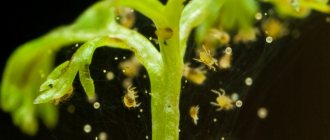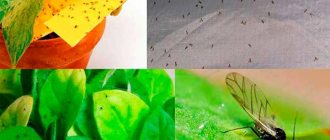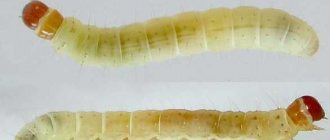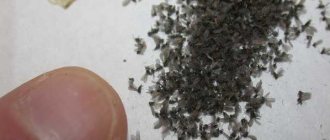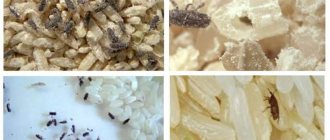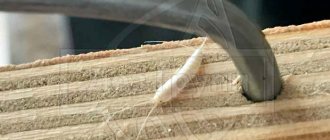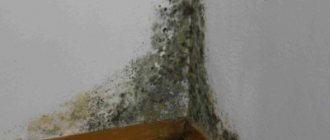Description of the sciarid fly (fungus gnat)
Sciara fly, order Diptera, family Sciaridae (sciarids) is a small black-gray mosquito about 1.5 mm long with a narrow body and a rounded head. The insect has only a front pair of transparent wings; the hind wings are transformed into club-shaped halteres. Mouthparts are sucking. They fly well and, in suitable conditions, easily reproduce in large numbers.
| Fungus gnat | A clutch of fungus gnat eggs in a flower pot. | Fungus gnat larvae damage the roots, causing rot. |
Adults do not harm plants, but lay small eggs on the surface of moist soil. Larvae later appear from the eggs - translucent, legless worms with a black “head” measuring 8-10 mm. The mouthparts are gnawing. Typically, the larvae develop in the soil on rotting plant tissue. However, indoor culture often lacks food substrates, as a result of which tender young roots and underground shoots of plants can be gnawed, which poses the main danger.
What is important to know about fungus gnats in order to successfully fight them?
There is no need to panic if large numbers of flying flies suddenly appear at home. First, you should try to figure out who they are and where they came from, and depending on the result obtained, choose a method of getting rid of them.
Do not confuse them with the fruit fly Drosophila! First, look at the flying specimens and make sure that they are sciarids. Mosquitoes, compared to Drosophila, are graceful and slender. The head and chest are larger than the body, the abdomen is thin, about 0.5 mm. Drosophila is a fly, albeit a small one. The abdomen has the proportions of a fly, thicker, without a sharp difference between it and the chest. It appears more often on spoiled fruits, hence the name.
Now, after digging up the soil a little, see if there are sciarid larvae there. If not, then everything is great: it is enough to destroy only the flying mosquitoes, which is not so difficult.
If you do find thin white larval worms with a black head and a segmented body, then this too can be solved. It should be taken into account that worms can also be soil nematodes or young earthworms. At high magnification, it is clear that the body of nematodes is unsegmented, and the head is not prominent in both nematodes and earthworms.
Fungus gnat or sciarid
Home flowers create a cozy atmosphere, make the air cleaner, and make us happier. But sometimes all the joy is overshadowed by such a nuisance as the appearance of midges or, more precisely, sciarids. They can attack any houseplant, but Saintpaulias (violets) are especially affected.
Sciarids (lat. Sciaridae), also known as fungus gnats , are small insects from the order Diptera (lat. Diptera). The first representatives of sciarids appeared many millions of years ago; now these insects are considered one of the most ancient living organisms that have survived in our time. Currently, about one and a half thousand different species belonging to thirty genera have a scientific description. And about twenty thousand more species have not yet been thoroughly studied. Naturally, all these types of sciarids differ from each other in size, color, and so on. But these differences are practically invisible to the human eye and are visible only under a microscope.
For domestic plants in the middle zone, three types of sciarids are mainly dangerous: Bradysia, Sciara, Lycoriella. They are all very similar to each other.
In general, adult fungus gnats are small flies, 3-4 mm long, usually black or dark gray in color. Young sciarids are mosquitoes about 2 mm in size, and the larvae are white worms with a black head.
The peak of fungus gnat reproduction usually occurs in the cold season, when plants are watered less frequently, but the soil dries out more slowly. The earth becomes too acidic, which leads to the proliferation of insects, just like watering a flower with tea leaves, creating a nutrient medium for them.
The main harm to the plant is caused not by the midges themselves, but by their larvae, which develop in moist, acidic soil and feed on the tender tips of the roots, thereby undermining the basic vitality of the plant. A plant with an affected root system usually becomes sick, withers, does not bloom, and may eventually die. The damage caused by adult sciarids cannot be called devastating. The owners are mainly upset that insects spoil the appearance of the plant with their presence. However, if the number of midges increases significantly, they begin to feed on the above-ground parts of the plant, preferring tender young shoots.
To understand how to get rid of midges in indoor flowers permanently, you need to know the channels of their penetration. Fungus gnats enter the room from the outside, for example, through hoods, or with a bouquet brought from the forest. Rooms with warm and humid climates are especially suitable for them. Another popular habitat for sciarids is food waste, such as rotten fruits or vegetables.
But still, most often fungus gnats are introduced with newly acquired potted plants, so you should take it as a rule:
Quarantine involves a thorough inspection of the new plant, including, if possible, the root system, then the plant must be washed and treated with phytoverm.
If, nevertheless, uninvited guests have settled in a flower pot, how can you get rid of them with minimal losses and without harming the plant?
Methods of treatment.
There are a great variety of ways to treat plants from sciarid invasion. First of all, it is advised to reduce watering the plant so that the soil dries to a depth of 2.5-5 cm. However, from my own experience I cannot call this measure at all effective. Reducing watering of Saintpaulias, for example, led me to their terrible dissatisfaction; the plants dropped their leaves and looked offended and depressed. And the sciarids flew and continued to fly. Of course, such abuse of plants must be continued long enough to starve out the hated mosquitoes, but, unfortunately, not every flower can withstand a period of prolonged drought, and there are some for which it is generally contraindicated.
You can try to catch flying insects with a vacuum cleaner or with yellow adhesive tape, which is best placed horizontally relative to the soil. You can water the soil with water with citromon or askofen (half a tablet per 3-4 liters of water).
Sometimes sticking half a clove of garlic or orange peels into the soil helps. It is recommended to use means to combat blood-sucking insects such as "Raptor", various aerosols, fumigators, etc. However, fighting adult insects does not help in any way to get rid of the larvae.
You can also coat the edge of the pot with all the well-known Mashenka chalk.
You can remove the top layer of soil to a depth of 1.5-2 cm and replace it with sand. Insects do not lay eggs in sand, which will ensure quick disposal of sciarids. You can lure the larvae using potatoes. Small cubes of potatoes or carrots (about 3.5 cm) should be placed on the surface of the soil for 2-3 days. The larvae will crawl straight to it and begin to actively eat. Soon you will be able to see how many of them have gathered under the potatoes. It, of course, will need to be removed along with the larvae to prevent rotting.
I don't think the damage caused by sciarids is so great that insecticides need to be used. However, if you do not have any prejudices against chemistry (and in vain), and the number of insects has become simply catastrophic, you can water the soil with Aktara. In general, insects multiply very strongly, mainly in winter, when the heating is on. In the spring, if the humidity in the apartment decreases, the number of insects drops sharply.
The article uses photos from the following sources:
A set of measures aimed at destroying all forms of fungus gnat
It is not necessary to perform all the suggested actions - determine the extent of damage to your collection and select what is necessary.
Important: approach the problem carefully and carefully
If you fight only larvae or only flying mosquitoes, there will be no benefit. When starting the “battle”, try not to deprive anyone of your attention, and then success is guaranteed to you
- Determine where and how they could get to you and check all possible places where the mosquitoes “reside.” Carefully remove all organic debris and dead parts from the plants.
- If your mosquitoes are coming to you from the basement of your house through hoods, pipes and ventilation shafts, you are very unlucky. It is almost impossible to eliminate dampness in the basement, so mosquitoes, unfortunately, will become your regular guests.
- Install a very fine mesh on the ventilation grilles, through the holes of which mosquitoes will not be able to get into the apartment.
- Check the soil in the pot - if it is heavily infested with larvae, change it to a fresh, breathable soil mixture suitable for the composition of this plant.
- Check the root system of the plant: if there are signs of root rot, take action
- Gather all the plants in one room. It should be well ventilated, and it is better to have a high-quality hood.
- Treat the premises with one of the means against flying insects in the form of an aerosol, for example, “Raptor”, “Raid”, “Neo-dichlorvos”. Make sure that there is no food, utensils, personal items, etc. in the treatment area. Cover the aquarium, remove the cage with birds or small animals.
- Also spray the shelves and window sills on which the plants stand to avoid “revenge” from surviving specimens in the future. Don’t forget to thoroughly clean all surfaces with soapy water and rinse several times with clean water.
- Any available insecticide is suitable for chemicals: Agravertin, Aktara, Inta-vir, Fitoverm, Actellik, Kinmiks, Karbofos. Dilute the working solution according to the instructions and thoroughly water the soil in the pot twice with an interval of 7 days. After treating the soil with a pest control drug, you should not water the plants for at least 3-5 days, so as not to weaken the effect of the drug by reducing its concentration and being washed out of the soil coma.
- For larvae in the ground, soil insecticides are used, for example, Bazudin, Grom-2, Pochin. In pots infested with sciarid larvae, remove the top layer of soil (about 3 cm) and replace it with the following mixture: new breathable soil and several Bazudina granules. Or simply scatter the granules over the surface of the earthen clod and carefully mix them with the top layer. When watering, the drug will dissolve and penetrate into deeper layers, killing the larvae living there. However, it is convenient to use such products if there are few infected plants, otherwise it will take a very long time to lay out and mix the drug in each pot.
- Leave everything for a while, preferably overnight. Close the door tightly and leave the room. In the morning you can move the plants to their places.
- In the room where you carried out the treatment, open the windows or turn on the hood for a long time. Collect the “bodies” of the flying representatives of this pest that fell in the unequal struggle, and clean the premises.
Chemical methods of disposal
In rooms where there are insects, chemical treatment is carried out using aerosols. They are sold in household chemical stores.
Effective means are Raptor and Raid. Before starting treatment, it is important to remove food products and protect animals from contact with the aerosol.
Important! If there is an aquarium, it is covered so that volatile particles of chemicals do not get inside.
The aerosol is used to treat indoor air, window sills, window frames, and shelving. After 4-5 hours, all surfaces are thoroughly washed with soapy water and clean water.
Other effective chemicals:
- Fitoverm, Actellik, Kinmiks. The solution is diluted according to the instructions. The soil is watered 2-3 times a day, once a week. After treatment, the soil is not moistened for 4 days. Otherwise, the effect of the chemical used is weakened and its concentration in the ground decreases. The treatment is carried out to get rid of the larvae that have appeared in the earthen coma.
- Bazudin. These are granules that are poured into the ground where the larvae are. First remove 2 cm of soil. Next, add granules and clean, uncontaminated soil on top. If the infection is minor, it is allowed not to remove the soil, but simply sprinkle granules on the surface. During watering, they dissolve and destroy the larvae.
- Neo-dichlorvos. When there are a lot of insects flying in the room, they are collected with a vacuum cleaner and sprayed into the air.
- Sticky traps. They trap insects. It is recommended to install them next to flowerpots.
- Chalk "Mashenka". It must first be crushed to a powder state. Draw stripes with crayons on the surface of the pot.
Note! When using chemicals, it is necessary to ensure personal safety.
When working with aerosols, you need to wear goggles, rubber gloves, a gown and a respirator. After treatment you need to take a shower.
5 hours after spraying, the room is ventilated. During treatment, animals and small children must be removed from the house or apartment.
Prevention of appearance and reproduction
To prevent the appearance and introduction of sciarids, it is necessary to exclude conditions. favorable for their reproduction:
Do not over-wet the soil in your flower pots, and keep an eye on the amount of water in the trays of your potted flowers. If the water stagnates, the roots will begin to rot, and this is an excellent breeding ground for mosquitoes. The deposition of larvae can be prevented by keeping the top layer of flower soil slightly dry (about 2 cm for a medium-sized pot, up to 3-4 cm for large flowerpots). Use the top layer as drainage: gravel, small expanded clay. Sprinkle a few centimeters on top of your plant. Then, when watering, the water will quickly leave the top layer, thereby depriving the insect of the opportunity to lay eggs. When replanting or adding soil to a flower, use specially treated substrates; it is even good if the composition contains elements that are not very edible for sciriada: particles of pine needles, bark, coconut fiber or coarse fibrous peat. However, we should not forget about the plant’s need for any additive. You should not use soil for replanting flowers, the quality of which you are not particularly sure of. If there is any doubt that it may contain any pests, it should be frozen for 2 days in the freezer, and in winter simply outside. Clean and remove faded flowers, leaves, and rotten roots from the surface in a timely manner. Keep your house clean, make sure there is no food waste left, and promptly throw away spoiled foods that mosquitoes might “like.” To kill flying mosquitoes, you should treat the room with a special aerosol product. Spray the product on window sills, shelves, and racks. For safety, make sure that when spraying the product does not get into food or dishes.
Use with caution in a room where there is an aquarium or other pets. If the prevalence of bugs is high, it will be more effective to use chemicals to treat the contaminated soil with a solution. After taking measures to destroy fungus gnats, thoroughly ventilate the room and carry out wet cleaning.
You should know how to deal with thrips and scale insects on indoor plants.
Measures to control soil flies
If a swarm of fungus gnats is discovered, it is better to immediately take radical measures. You need to fight the sciarids on two flanks - from the air and on the ground. If you poison only flying individuals, then new sciarid larvae will hatch in the soil every day.
To destroy the larvae, you need to use a solution of insecticides. I would like to immediately warn you that the more powerful the drug, the more effective the fight. For example, a solution of fitoverm may be ineffective in some cases. Actellik (2 ml/l), Decis or Karbofos are best suited. Do not be afraid of causing harm to the plant; almost all produced drugs for controlling pests and diseases are not phytotoxic. If “nests” or clutches of fungus gnats are found in more than one pot and the flies fly, as they say, in flocks, then it is better to re-treat with an insecticide during the next watering.
You will also have to fight flying insects; for this it is better to use the same means that are used to fight flies. These are aerosols, like the well-known dichlorvos and the like. Sometimes you can come across a recommendation to use “Raptor” or “Fumitox” plates in such a case, but they are usually not very effective. If many of us have more than once encountered the fact that, having turned on, say, “Raptor” at night, some very persistent mosquito was still discovered in the morning, then what can we say about sciarids - you cannot completely rely on these remedies, even if change records quite often. Although you can try these products first, the main thing is to tightly close the aquarium, if you have one. If within an hour after turning on the “anti-mosquito” plates (although they can be in liquid form) the sciarids do not die, then you can take on dichlorvos.
If fungus gnats breed in winter, then it is best to take the plants (already watered with insecticide) into a separate room or stairwell (as long as the neighbors don’t notice) and spray the soil in the pots with an aerosol from above. After two minutes, the plants can be brought in and left, for example, in the bathroom. The room where the plants stood was also treated with an aerosol and thoroughly ventilated after half an hour. Flowers can be brought in only when the room becomes warm. If sciarids appear in your home in the summer, then the easiest way is to take all the plants to the balcony (outside) and carry out all treatments there.
In pest control, all means are good, as long as there is no harm to the plants, so clap your hands and catch flying flies with a vacuum cleaner.
Treatment of the room and pots with plants with aerosols against flying insects, as well as watering the soil with insecticides, may have to be repeated, preferably until the pests completely disappear.
Prevention measures for sciarids
Do not use food products or infusions from them to feed plants. Such as meat or fish broths, drunken tea, sugar water, milk, etc. Indoor plants have a physiology not like that of humans; while food products decompose into components that are easily digestible by plants, but simply rot, entire collections of pests can settle and multiply on plants and in the soil.
If you are going to feed the plants with organic matter, such as mullein, then it is better to do this without watering the cow dung infusion, but by adding it to the soil when replanting. The most convenient option is to smear the walls of an empty pot up to the middle of their height with a semi-liquid cake, then place the plant and fill the space between the roots and the walls of the pot with earth. In this case, the smell of rotting manure does not remain.
If you have a lot of plants, especially those that like moist soil, then it makes sense to switch to tray watering to keep the top layer of soil dry. But at the same time, we must remember that the water in the pan should be fresh, and not sour, with the appearance of swamp mud.
Timely control of emerging insects can also be considered an important preventative measure. It is impossible to start the reproduction of sciarids to such an extent when they already fly in flocks
Otherwise, you may not find a single plant that is not affected by larvae, no matter how good the soil is.
In order to prevent any pests and diseases, soil purchased or prepared by yourself must be disinfected (steamed with boiling water, fried in the oven, sprayed with insecticide, kept in the freezer, etc.).
Ways to combat fungus gnats
In the vast majority of cases, the appearance of winged small fry is an annoying, but easily correctable problem. If you have the necessary knowledge, the plant can be saved, because there are many means of getting rid of midges, both purchased in flower shops and folk ones. It is important to consider that the sooner measures are taken to destroy harmful insects, the better: fewer pots will be infested with larvae. In a not very advanced situation, the fight against midges is quite effective using folk remedies, but if the entire soil is contaminated, then it is better to immediately use chemicals, before using which you must read the instructions.
To destroy adult individuals, you can use Raptor, Neo-dichlorvos, or Mashenka chalk.
And Intavir, Karbofos, Fitoverm, Agrovertin, Grom-2, Bazudin will help against the larvae.
Among the leaders is the drug Fly Eater, which destroys the entire population of pests and does not harm the plant.
After treatment, do not water the plant for about 5 days, let the drug work. When treating the plant itself with chemicals, do not forget about the space around it; it would not be amiss to spray the insecticide on the surfaces on which the bowl and window sills were placed. racks, shelves.
[!] Precautionary measures. Treatment should be carried out using protective equipment for the respiratory tract, hands and eyes, in a ventilated area. Keep dishes, food and kitchen utensils away from the processing area. Keep pets and children away from freshly processed flowers! After 1-2 days, wash treated surfaces, window sills and shelving with plenty of soap and water.
It may happen that even the use of special means will not bring a positive result. And again, do not despair, because not all methods have yet been used. The surest remedy: transplant the plant into a pot with fresh soil. When replanting, it is necessary to carefully examine the entire root system and treat it with special means, as well as rinse it in a solution of potassium permanganate: mycelium of harmful fungi often settles on roots damaged by parasites.
A few more ways to get rid of flying flies:
- it is possible to use a sticky fly trap, which must be placed directly next to the bowls with the infected plant
- use of fumigators such as “Raptor”, “Raid” in the immediate vicinity of a plant infected with sciarids
- an exotic method is to use the insectivorous plant Nepenthes, which is quite capable of eating flies that carelessly fly into its traps
- the use of aromatic oils, citrus peels, incense to repel flies, the method is effective only when the number of insects is small
The danger of fungus gnats for humans and indoor plants
It should immediately be noted that sciarid midges do not bite humans and do not drink their blood. This is confirmed by research by American scientists. They, unlike midges, do not swarm near the face and do not get into the eyes. However, sciarids are carriers of dangerous fungal diseases that are harmful not only to plants, but also to people. Severe respiratory diseases can develop in humans after contact with infected plants and inhalation of mold spores, which are carried by sciarid flies.
As for plants, the favorite food of indoor plant pests in the ground are the roots of poinsettia, Saintpaulia, anthurium, hibiscus, orchids and other houseplants. In pots where sciarid larvae have appeared en masse, flowers stop developing normally, they lose their attractive appearance, become lethargic and lose their ability to bloom. All this indicates that care must be taken to eliminate dangerous pests from indoor flowers as quickly as possible.
How dangerous are sciarids for indoor plants and seedlings?
First of all, fungus gnats are the worst enemies of mushroom growers, because by attacking the fleshy parts of the stems and caps, they turn the mushrooms into a spongy mass.
In plant production, female sciarids lay eggs near plant roots. An adult female can lay about three hundred eggs during its short life (they typically only live for about a week). Within 4-6 days, the eggs hatch into voracious larvae, which begin to eat the root tissue, disrupting its absorption capacity.
This leads to yellowing of the leaves, stunting of growth, rapid wilting and, subsequently, the death of the plant. In addition, the attacked plant is exposed to various infections and fungal diseases. The younger the plant, the more damage will occur (especially if it grows in a humid environment). Also, the larvae can begin to eat the young foliage of the seedlings, destroying the seedlings completely. This happens when there is not enough organic material in the soil.
Adult midges do not feed on plants, but they can carry diseases, primarily fungal ones. This is because they can easily collect spores from infected plants or soil and spread leaf spots, mold, rot and more.
Fungus gnat. © Corey Raymond
You can get rid of flying insects in several ways:
- Collect with a vacuum cleaner.
- Treat the room with a drug against flying insects in aerosol form (“Raid”, “Neo-dichlorvos”, etc.).
- Use a special sticky fly trap tape, hanging it near the plants. Advice - stock up on sticky fly traps in the summer: in winter there are no traps in stores!
- Use “scotch tape” as a last resort: place small strips with the adhesive side next to or on the pots.
- Close the windows and turn on one or more fumigators for a long time (depending on the size of the room and the number of plants), placing them as close as possible to the cluster of plants. You can use different plates, “Raid”, “Fumitox”, etc.), the main thing is to change them quite often, about once every 1.5 - 2 hours.
- An unconventional way: get nepenthes, an insectivorous plant that can now be found in flower shops. It is supposed to “eat” all the midges. In principle, “there is” - it will be there, but not all of them, but only those who want to get into his jug. In addition, Nepenthes itself is not so easy to keep indoors.
- Pour crushed Mashenka chalk (for cockroaches) or draw stripes on the top of the pots.
- Cover the plants with fresh citrus peels, pieces of garlic, branches of incense, sprinkle with dill, and coat the pots with anise oil. All of the above must be updated frequently. This method is effective if a couple of insects accidentally flew into your area and have not yet had time to get used to it, but, unfortunately, this moment is very difficult to detect.
Sources
- https://apest.ru/moshki/kak-izbavitsya-ot-stsiarid/
- https://kopilkasovetov.ru/domovodstvo/chem-vyvesti-mushek-v-tsvetochnyh-gorshkah-sredstva-borby-s-gribnymi-komarikami/
- https://www.flowersweb.info/pests%26diseases/pests/lycoria.php
People's recommendations
Having discovered that fungus gnats have appeared in a flower pot with your favorite violets, you need to reduce watering. If the degree of infection of a plant with sciarids is high, then it will be necessary to combat flies in flower pots using more radical means. It is necessary to transplant the flower into new soil and remove part of the rotten root system.
If the roots of the plant are not damaged, then it is enough to change the top layer of flower soil. It is advisable to remove sciarids using affordable and safe midge repellents:
Folk remedies for fungus gnat
- Spray the contaminated soil and the above-ground part of the plant with an infusion prepared from dry tobacco. It should be processed five times at weekly intervals.
- A soap solution prepared from thirty grams of shavings dissolved in a liter of water. Spraying is carried out by analogy with the previous method.
- Organization of upper drainage. Pour a layer of fine gravel, coarse sand or expanded clay onto the soil surface. After watering, the drainage will always be dry and will not allow sciarids to reproduce.
- A light pink solution of potassium permanganate will disinfect the soil in the pot.
- As natural repellents, you can use citrus peels, garlic cloves, anise oil, which is used to lubricate flower pots, or chopped dill sprinkled on the top layer of soil.
- Sticky midge traps placed near flower pots.
All these remedies will help get rid of fungus gnats. You can use the original unconventional method. To do this, flower growers recommend having Nepenthes in your home, an insectivorous plant that will reduce the number of harmful insects.
Preparatory activities
Before taking effective action to combat the pest of indoor plants, it is necessary to establish their number, their place of mass habitat, and only then decide how to get rid of sciarids and which method to choose. Initially you need to do the following:
- inspect the premises for the presence of food waste and establish ways of penetration of sciarids into the apartment;
- install protective nets on hoods and ventilation ducts;
- check the soil in flower pots for the presence of larvae and, if necessary, replace it with fresh substrate;
- conduct an audit of the root system of plants in order to detect rotten areas;
- reduce indoor air humidity through additional air ventilation.
After carrying out this set of measures, you can choose effective methods of combating the fungus gnat.
If the sciarids find favorable living conditions in the apartment, there will be no end to them. Therefore, you will have to find out the “tastes” of these insects and try to take preventive measures against their appearance and reproduction:
The main rule is to avoid waterlogging the soil in pots. If you tend to flood your plants, then adjust the watering: waterlogging the soil in pots creates conditions for the active reproduction of sciarids
Never water a plant again if the soil on top of its pot is not dry! If you accidentally water the plant too much, drain the excess water from the pan and thoroughly dry the earthen ball before the next watering.
When insects appear, it is important to prevent their further reproduction and spread.
- Promptly remove dead parts of plants (withered leaves, flowers, underground parts) remaining in the pot. Monitor the state of the supply of vegetables and fruits in the apartment and your food waste, promptly remove and throw away everything that could become “home and food” for sciarids.
- Use sterilized substrates for your plants.
It is good if the soil contains components that are “unpalatable” for flies: coarse fibrous peat, pine needles, bark, coal, coconut fiber. However, it must be remembered that the composition of the soil should first of all be selected in accordance with the needs of the plants, and not the flies.
- If you are not sure about the cleanliness of the soil, spill it with water and freeze it for at least a few days (in the summer - in the refrigerator, in the winter - outside or on the balcony). It is safer to leave the soil prepared for future use on the balcony for the winter, and use it for replanting in the spring. Long-term freezing is a good remedy for many soil pests.
What to do to get rid of fungus gnats
First, determine their number and the “front” of the fight against insects, then select the appropriate measures:
- Determine how the mosquitoes got to you and think about possible habitats. Carefully inspect the area for food debris.
- Check hoods, grilles leading to basements and ventilation shafts. Since it is hardly possible to eliminate moisture in basements, you will have to fight it using available means: install a mesh on the ventilation grilles, with fairly small cells, so that mosquitoes do not get through it.
- Inspect the soil in the flowerpots for the presence of larval eggs and check the condition of the roots of the flowers; if necessary, replace with fresh substrate.
- There should be good air circulation in the room where flowerpots are located.
Reasons for appearing in the house
If you notice several individuals of flying sciarids in the house, there is no need to panic. First you need to find a way how they got into the house.
The first step is to check the soil of your flowers, lightly dig up the substrate and make sure there are no deposited larvae or worms there.
Mosquitoes can enter the house in the form of larvae deposited in the soil of a newly purchased flower from the store. There they develop into adults.
However, the appearance of insects in the house may be due to other circumstances: nearby basements, ventilation shafts. Mosquitoes are attracted to rooms where it is warm and humid, and they can get through the exhaust pipe in the kitchen or bathroom. It is possible that under good conditions for them, the larvae will be able to lay larvae on the moist soil of the plant and reproduce.
How to distinguish fungus gnats from fruit flies?
In fact, fruit flies (fruit flies) also often show interest in containers with seedlings and pots of indoor flowers. But still, fruit flies are not at all dangerous to plants and they may only be interested in the soil that they use to breed offspring. At the same time, neither fruit flies nor their larvae eat any parts of plants. And the only problem, if they choose the soil, will only be to increase the number of fruit flies in the house. But sciarid larvae, as we know, are very dangerous, and it is very important to identify them in time.
At first glance, it may seem that fruit flies and fungus gnats are twin brothers, and, indeed, both of them are essentially small midges. However, if you take a closer look, you can see very significant differences. In particular, sciarids can be easily distinguished from Drosophila by their heads. Fruit flies have a very large head with large eyes that are often reddish in color. Whereas fungus gnats have a small head with small eyes, on which antennae are also clearly visible, which are not found in fruit flies. The body of sciarids is more elongated and graceful than that of fruit flies, the legs are noticeably longer and the insects are also slightly smaller in size.
Prevention.
It is not advisable to water the plants too much, because... Fungus gnats develop most intensively in moist soil. In soil mixtures from some manufacturers, fungus gnats are almost always present. Therefore, the soil must be sterilized before use. Sometimes mulching helps prevent the appearance of sciarids and reduce their number - you can cover the soil with a layer of sand or a cut out circle of paper. You cannot water plants with various “folk” remedies such as tea, broth or water left after meat. You should also regularly remove dry leaves and other organic debris from the soil surface, which serve as good food for the larvae.
What do fungus gnats look like?
First of all, if you notice a couple of annoying insects, usually small flies, you need to check all the pots. If at first sciarids appear in pots with a waterlogged substrate, then with intensive reproduction of these insects, moderately moist soil will suit them, and then, if they are hunted, they will agree to fairly dry soil. So you need to check all containers where there is earth.
If you shake or lightly tap a pot with a plant and a flock of flies flies up above the surface of the ground, then most likely there is a clutch of eggs there. If you look closely, you will notice that the flies fly at different ages: light gray ones are still translucent and larger ones are already black. In such a pot, it is better to immediately replace all the soil. Since it has most likely already been processed by worms and is in a rotten state, and, in addition, it is necessary to check the condition of the roots of the plant.
If you take the plant out of the pot and scatter the soil into a tray, then in the damp soil you can see whitish, translucent larvae with a black head, up to 5 mm long. It is much easier to detect the larvae if you water the soil in the affected pot with an insecticide - they usually crawl to the surface, and you can see them writhing.
Biological characteristics of the fungus gnat
The sciarid fly is a small mosquito whose body length ranges from 1.5 to 4 mm. In young individuals it reaches two millimeters. The color of the outer cover of adult insects is black, while that of young insects is light gray. The fungus gnat has a well-developed front translucent pair of wings, thanks to which they can fly well. The hind wings have lost their original purpose. They have transformed into club-shaped halteres, so during flight the insect makes a characteristic squeaking sound. The sciarid's mouthparts perform a sucking function.
Adult sciarids do not harm plants because they do not feed. Under favorable conditions, insects reproduce very quickly. The female fungus gnat lays eggs on the surface of well-moistened soil or in clods of soil between the roots of indoor plants. One clutch can contain up to three hundred eggs. After a few days, worm-shaped, legless fungus gnat larvae emerge from them. Their body length can range from two to ten millimeters. It is translucent, with a clearly visible intestine and a characteristic black head. It can be used to distinguish representatives of flower pests from annelids. Sciarid larvae have gnawing mouthparts. They usually develop on rotting plant debris present in the soil. However, being in the flower pots of indoor plants, they may lack food substrates. Midge larvae feed on delicate food systems and underground shoots of flowers, causing irreparable damage to plantings. After some time, pupation occurs and the young fly emerges. Leftover shells decompose in the ground. Please note that they do not tolerate dry soil. Sciarid larvae removed from a moist substrate die within a short period of time.
How to get rid of fungus gnat, prevention
If black midges appear on seedlings, reduce the frequency of watering and the amount of water. Do not moisten the soil for a while, let the top layer dry out, water lightly when the leaves wilt a little. In the intervals between such waterings, the larvae will gradually die.
Folk way to combat sciarids on tomato seedlings:
- soak 2 cigarettes (strong, without filter) in a glass of water, leave for a day;
- close the drain holes in the cups, pour the infusion over the seedlings until the soil is completely wet, leave it for half an hour and open the holes;
- the next watering with infusion is carried out when the top layer of soil dries, then ordinary water is used, but the frequency of procedures is left the same.
In the fight against fungus gnats, shallow loosening of the soil helps; in the beds the depth is 3–5 cm, in the case of seedlings up to 1–1.5 cm. If you find single individuals, place fresh citrus peels or cut garlic cloves around the containers with seedlings, their smell will scare away the pest.
As soon as you notice black midges flying in flocks in tomato beds, immediately start fighting. Don’t expect the sciarids to leave the garden on their own; if the population is small, they won’t cause significant damage to the roots, but the danger of contracting diseases remains. First, we will describe folk remedies for spraying; they can be used at all stages of tomato growth:
- chop a glass of garlic cloves, add a liter of water, leave for 48 hours. Strain and dilute the infusion in a bucket of water;
- mix a tablespoon of ground black pepper, 3 tablespoons of dry mustard and 3 crushed cloves of garlic, add a liter of water, leave for 2 days. Strain the infusion, add 5 liters of water.
Important!
You need to spray the plants and soil until the pest is completely eliminated. You can add laundry soap to the infusions for better adhesion and enhanced effect (no more than 40 grams).
If large colonies of the pest appear, when traditional recipes do not give results, you will have to use chemicals. Aktara, Actellik, Decis, Karbofos and the biological product Fitoverm help in the fight against imagoes. To combat larvae, mix Bazudin or Thunder-2 with a small amount of peat or sand and scatter around the tomato bushes. The protective effect will last a month, then repeat the procedure.
If an insect has taken a fancy to greenhouse tomatoes, close all windows and doors and turn on the fumigator for several hours. All the described options for combating the fungus gnat give a good effect, but the best protection is prevention:
- sow dill between the rows, it attracts insects that feed on sciarids;
- the aroma of marigolds and calendula repels midges;
- in the fall, remove all plant debris, dig up the soil to the floor with a shovel, most of the larvae will die from frost;
- observe crop rotation;
- avoid excessive moisture in tomato beds;
- remove weeds and do not place garbage containers near the garden.
The appearance and reproduction of insects can only be controlled by creating unfavorable conditions. Prevention coupled with folk remedies is quite enough to successfully combat the fungus gnat; the use of chemicals is the last resort.
Tips on how to deal with fungus gnats in flowers
Christiana: It’s not the insects themselves that pose a danger to the plant, but their larvae! If there are a lot of them, then it is better to change the soil to fresh, loose soil. You can also water it several times with a manganese solution, only very weakly, so as not to burn the roots. As I heard, this is a very good remedy.
Weselova: Only Grom-2 helped me.
Kasandra: POCHIN always helps me, lightly sprinkle the soil on top or when replanting, add it to the soil. Choose what you have available in stores.
Elena T: Bazudin didn’t help, the actor helped. I don’t recommend mixing both drugs; I developed mold. For flying insects, you can hang trap tapes. But if you overdo it with watering, they will appear again.
Lusi: Fungus gnats and their larvae are not such a terrible beast. Well, firstly, if you have a lot of these mosquitoes, then this is a clear sign that you are flooding your flowers; this is much worse than mosquitoes. Take a break from watering, dry the flowers well, so that the soil is dry for about half of the pot. Buy bazodin, dilute it according to the instructions and water all the plants, you must water everything and abundantly so that the water leaks out and does not flow like a river from the pan, wait 15 minutes and drain the excess water from the pans. And after two weeks, for prevention, dilute potassium permanganate (so that the water is slightly pink) and water again.
irina-bahus: I water it with Inta-Vir, it always helps.
K.I.S.: They really love moist soil - that’s why it’s difficult to fight them. The larvae hatching from the eggs eat organic matter, and when there is little of it, they suck everything from the plant. I had them in a pot of hibiscus, when I had to shake out the pot, it was almost all white at a depth of 1 cm. I found the Bazudin product. You just need to sprinkle (a little) small granules on the soil around the plant and water it. There will be a nasty smell, it will go away after a while, but will recur when watering. This will kill the larvae. And the midges themselves die over time. The main thing is that juveniles do not form, and this remedy seems to help. At least they don’t fly for me anymore.
Lynx: I declared war on these dirty tricks! She grabbed a basin, filled it with 5 liters of water and threw in an Inta-Vir tablet. Well, in general, there was no nasty smell... and no sense either. The next day I found these white worms in an absolutely mobile state. Then the next day I bought two ampoules of Actellik. Dissolved in water. White as arsenic (Mamma Mia, what a stink!). I took the flower (coleus) to the balcony and poured it with a liquid prepared in advance (actellik, ampoule per liter of water).
Orchid: I know that many people deny this, but personally, I successfully fight fungus gnats with liquid Raptor. Or rather, lately they prefer not to start (Raptor turns on every evening). I use the odorless Raptor liquid fumigator. Simple (30 nights) and somehow enhanced (45 nights).
evridika: The store recommended Tavric to me. You spread it on the soil in a dense layer, it destroys fungi and parasites, and fertilizer at the same time. It’s also different colors, it looks like coconut flakes, only in color.
Masha: How I overcame mosquitoes - actellik + fly tape. Water it with Actellik and lay the tape near the ground. What is important is that it is better to place it directly on the ground of the pot. and not just nearby. Actellik kills larvae in the ground (only it smells terribly), and the tape catches adults - also with a bang. You can repeat the actellic in a week. I advise you not to remove the tape for a month.
Vika: Take a pack of inexpensive cigarettes, tear them and sprinkle tobacco on the ground so that the entire area of the pot is covered. Let this tobacco sit until it dissolves itself.
Reasons for the appearance of fungus gnats in an apartment
Fungus gnat in the house To get rid of gnats in indoor plants, it is necessary to establish the reason for their appearance in the room. The most common factors for the existence of fungus gnats in an apartment are:
- increased humidity in the apartment and improper care of house plants;
- purchasing a flower infected with sciarid larvae or adults from a specialized store;
- sciarid can enter the apartment through ventilation ducts, an open window or door;
- a warm and humid environment is an ideal condition for insect life. Having settled in such a room, they lay eggs in the flower substrate and continue to exist.
Having established how the sciarid flower flies ended up in the apartment, it is necessary to begin comprehensive measures to destroy the pests.
Causes of soil flies
Sciarids, like all flying insects, can enter a room through open windows, ventilation, or simply an open door. It is possible that you can bring home an infected plant from a store or introduce larvae with purchased and not disinfected soil.
But a fungus gnat entering an apartment does not always mean immediate multiplication of the colony. A waterlogged substrate promotes the proliferation of fungus gnats; mosquitoes are especially attracted to soil where the process of rotting or decomposition of organic fertilizers is actively underway. Therefore, first of all, mosquitoes lay eggs in pots with plants watered with tinctures of mullein and bird droppings. It has also been noted that fungus gnats tend to appear when water from an aquarium is used for irrigation, along with fish waste products.
